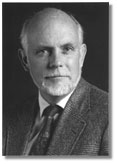| |
 |
Richard E. Smalley,
Ph.D.,
1996 Nobel Laureate,
Chemistry,
Gene & Norman
Hackerman
Professor of Chemistry
Professor of Physics,
Rice University
Rice University
|
Professor Smalley received his B.S. degree in 1965
from the University of Michigan and Ph.D. from Princeton
in 1973, with an intervening four-year period in industry
as a research chemist with Shell. During an unusually
productive postdoctoral period with Lennard Wharton
and Donald Levy at the University of Chicago, he pioneered
what has become one of the most powerful techniques
in chemical physics; supersonic beam laser spectroscopy.
After coming to Rice University in 1976 he rose rapidly
through the academic ranks, being named to the Gene
and Norman Hackerman Chair in Chemistry in 1982. He
was one of the founders of the Rice Quantum Institute
in 1979, and served as the Chairman of this interdisciplinary
Institute from 1986 to 1996. Since January 1990 he
has also been a Professor in the Department of Physics,
and was appointed Director of the new Center for Nanoscale
Science and Technology at Rice in 1996. In 1990 he
was elected to the National Academy of Sciences, and
in 1991 to the American Academy of Arts and Sciences.
He is the recipient of the 1991 Irving Langmuir Prize
in Chemical Physics, the 1992 International Prize
for New Materials (which he shares with his colleagues
R. F. Curl and H. W. Kroto), the 1992 E.O. Lawrence
Award of the U.S. Department of Energy, the 1992 Robert
A. Welch Award in Chemistry, the 1993 William H. Nichols
Medal of the American Chemical Society, the 1993 John
Scott Award of the City of Philadelphia, the 1994
Europhysics Prize, the 1994 Harrison Howe Award, the
1995 Madison Marshall Award, the 1996 Franklin Medal,
and the 1996 Nobel Prize in Chemistry.
His research at Rice has made pioneering advances in
the development of new experimental techniques (super-cold
pulsed beams; ultrasensitive laser detection technique;
laser-driven source of free radicals, triplets, metals,
and both metal and semiconductor cluster beams) and
has applied these techniques to a broad range of vital
questions in chemical physics. He is widely known
for the discovery and characterization of C60 (Buckminsterfullerene),
a soccerball-shaped molecule, which, together with
other fullerenes such as C70, now constitutes the
third elemental form of carbon (after graphite and
diamond). His group has also been the first to generate
fullerenes with metals trapped on the inside. His
current research is focused on the production of continuous
carbon fibers which are essentially giant single-fullerene
molecules. Just a few nanometers in width, but many
centimeters in length, these fullerene fibers are
expected to be the strongest fibers ever made, 100
times stronger than steel.
|
|

